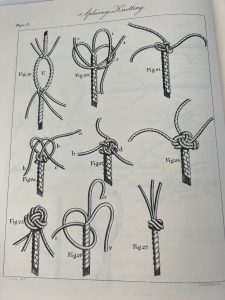Darcy Lever – The Young Sea Officer’s (1819)
It is my great pleasure to present to you this book, it is a gem for all maritime enthusiasts. The full title of the book is “The Young Sea Officer’s Sheet Anchor: Or a Key to the Leading of Rigging and Practical Seamanship”. The length of the title is not unusual for the books from this time of history. As we go from the past into ‘nova days’ time we can observe a shortening of titles, verses in songs, and so on. It seems to be very natural in our current times, to receive just short information to minimize the time cost of gaining knowledge. But this book is not from our time. It is from the past and gives us a snip of the specific knowledge; displayed in every possible small detail. To read this book is like discovering a user guide. Complicated steam machines in the 21st century contain drawings, explanations, and all necessary knowledge.
The language used in Darcy Lever – The Young Sea Officer’s Sheet Anchor
I asked myself: ‘Did you understand everything from this book?’, and the answer was “Hell, no”. The reason is the book contains tones of the specific nautical language. A lot of terms, from the book are forgotten and not used more than 100 years past. But it doesn’t matter. A great number of pictures and drawings inside the book, give us an explanations.
Why this book is so crucial for the shanty singer or shanty enthusiasts?
Well, every time I try to reconstruct some forgotten shanty I have an issue with one thing, imagine himself as a part of the gang heaving or hauling the rope during ship work. And it is not a general issue, I can easily Imagine pulling or pushing activities. There is a huge difference between when imagination is filled with imagining where this halyard ends you can Imagine a sailor shouting the yard “All Clear” from the yard, and you know what he did to be prepared for this shout when you know where belaying pins are; and why some old pictures show raise yard by pulling on board of the ship. This book gives you this information.
Conclusion
Well, every time I try to recreate some forgotten shanties; I have a problem with one thing: imagine myself being part of the crew; heaving or hauling the rope while working on the ship. And that’s not a general problem, it’s easy to imagine pulling or pushing. But it’s a huge difference; when a simple hazy image from our imagination; turns into a picture where you can imagine where that halyard ends; you can imagine a sailor screaming “All Clear” from the yard; and you know what he did to prepare to that scream when you know; where the belaying pins are and why in some old photos you can see halyard pulling from the side of the ship and not from the base of the mast. This book contains all of this information.
This book describes knots, rigging, and elements of all complicated machinery that operates sails on tall ships. It tells you how reef mainsail happens, how to install topmast on main masts, and tons of other information. If you buy it your shanty singing will be much less virtual, at least in your head, and definitely, you will be closer to discovering the true spirit of the sea shanties.
Do you want to be more involved?
You can find excellent records of sea shanties here. If you want to discuss this book or share your opinion you can do it in my Facebook forum here, or below post in the comment section.
Related to The Young Sea Officer’s
Glyn Davies – Cerddi Huw Puw (1922)








